Latest Energy Storage Trends in Multi-Energy Standalone Electric Vehicle Charging Stations: A Comprehensive Study
Abstract
:1. Introduction
2. Standalone Plugin Electric Vehicle Charging Station
3. RE-Based Hybrid Standalone PEV Charging Station Configurations
- 3.1
- Single energy storage system configuration.
- 3.2
- Hybrid energy storage system configuration.
- 3.3
- Swappable energy storage system configuration.
3.1. Single Energy Storage System Configuration
3.2. Hybrid Energy Storage System Configuration
3.3. Swappable Storage System Configuration
4. Expectations from Future Energy Storage Systems
4.1. High Power Density
4.2. High Energy Density
4.3. Environment Friendly
4.4. High Response Time
4.5. High Efficiency
4.6. Low Cost
4.7. Maintenance Requirement
4.8. Recharge Time
4.9. Self-Discharge Rate
5. Conclusions
Author Contributions
Funding
Institutional Review Board Statement
Informed Consent Statement
Data Availability Statement
Acknowledgments
Conflicts of Interest
Nomenclature
| BSS | Battery Storage System |
| CAES | Compressed Air Energy Storage |
| ESS | Energy Storage System |
| EVs | Electric Vehicles |
| FC | Fuel Cell |
| HRE | Hybrid Renewable Energy |
| HRES | Hybrid Renewable Energy System |
| MPPT | Maximum Power Point Tracking |
| REs | Renewable Energy |
| PEVs | Plugin Electric Vehicles |
| PHES | Pumped Hydro Energy Storage |
| SC | Supercapacitor |
| SCFC | Super Capacitor Fuel Cell |
| SMES | Superconducting Magnetic Energy Storage |
| SOC | State of Charge |
References
- Muqeet, H.A.; Javed, H.; Akhter, M.N.; Shahzad, M.; Munir, H.M.; Nadeem, M.U.; Bukhari, S.S.H.; Huba, M. Sustainable Solutions for Advanced Energy Management System of Campus Microgrids: Model Opportunities and Future Challenges. Sensors 2022, 22, 2345. [Google Scholar] [CrossRef] [PubMed]
- Javed, H.; Muqeet, H.A.; Shehzad, M.; Jamil, M.; Khan, A.A.; Guerrero, J.M. Optimal Energy Management of a Campus Microgrid Considering Financial and Economic Analysis with Demand Response Strategies. Energies 2021, 14, 8501. [Google Scholar] [CrossRef]
- Muqeet, H.A.; Munir, H.M.; Javed, H.; Shahzad, M.; Jamil, M.; Guerrero, J.M. An Energy Management System of Campus Microgrids: State-of-the-Art and Future Challenges. Energies 2021, 14, 6525. [Google Scholar] [CrossRef]
- van der Schoor, T.; Scholtens, B. Power to the People: Local Community Initiatives and the Transition to Sustainable Energy. Renew. Sustain. Energy Rev. 2015, 43, 666–675. [Google Scholar] [CrossRef] [Green Version]
- Di Somma, M.; Yan, B.; Bianco, N.; Graditi, G.; Luh, P.B.; Mongibello, L.; Naso, V. Design Optimization of a Distributed Energy System through Cost and Exergy Assessments. Energy Procedia 2017, 105, 2451–2459. [Google Scholar] [CrossRef]
- Li, F.-F.; Qiu, J. Multi-Objective Optimization for Integrated Hydro–Photovoltaic Power System. Appl. Energy 2016, 167, 377–384. [Google Scholar] [CrossRef]
- Lior, N. Energy Resources and Use: The Present Situation and Possible Paths to the Future. Energy 2008, 33, 842–857. [Google Scholar] [CrossRef]
- Chen, H.; Yang, C.; Deng, K.; Zhou, N.; Wu, H. Multi-Objective Optimization of the Hybrid Wind/Solar/Fuel Cell Distributed Generation System Using Hammersley Sequence Sampling. Int. J. Hydrogen Energy 2017, 42, 7836–7846. [Google Scholar] [CrossRef]
- Chicco, G.; Mancarella, P. Distributed Multi-Generation: A Comprehensive View. Renew. Sustain. Energy Rev. 2009, 13, 535–551. [Google Scholar] [CrossRef]
- Shahab, M.; Wang, S.; Abd ul Muqeet, H. Advanced Optimal Design of the IoT Based University Campus Microgrid Considering Environmental Concerns and Demand Response. In Proceedings of the 2021 6th International Conference on Power and Renewable Energy (ICPRE), Shanghai, China, 17 September 2021; pp. 798–802. [Google Scholar]
- Boulmrharj, S.; Khaidar, M.; Bakhouya, M.; Ouladsine, R.; Siniti, M.; Zine-dine, K. Performance Assessment of a Hybrid System with Hydrogen Storage and Fuel Cell for Cogeneration in Buildings. Sustainability 2020, 12, 4832. [Google Scholar] [CrossRef]
- Bartolucci, L.; Cordiner, S.; Mulone, V.; Santarelli, M. Ancillary Services Provided by Hybrid Residential Renewable Energy Systems through Thermal and Electrochemical Storage Systems. Energies 2019, 12, 2429. [Google Scholar] [CrossRef] [Green Version]
- Figaj, R.; Żołądek, M.; Goryl, W. Dynamic Simulation and Energy Economic Analysis of a Household Hybrid Ground-Solar-Wind System Using TRNSYS Software. Energies 2020, 13, 3523. [Google Scholar] [CrossRef]
- Kichou, S.; Wolf, P.; Kapler, P. Renewable Energy Supply for Remote Station Located in Antarctica—Simulations Based on Real Measured Data. IOP Conf. Ser. Earth Environ. Sci. 2019, 290, 012098. [Google Scholar] [CrossRef]
- Cai, W.; Li, X.; Maleki, A.; Pourfayaz, F.; Rosen, M.A.; Alhuyi Nazari, M.; Bui, D.T. Optimal Sizing and Location Based on Economic Parameters for an Off-Grid Application of a Hybrid System with Photovoltaic, Battery and Diesel Technology. Energy 2020, 201, 117480. [Google Scholar] [CrossRef]
- Edwin, M.; Nair, M.S.; Joseph Sekhar, S. A Comprehensive Review for Power Production and Economic Feasibility on Hybrid Energy Systems for Remote Communities. Int. J. Ambient Energy 2022, 43, 1456–1468. [Google Scholar] [CrossRef]
- Yuan, Y.; Wang, J.; Yan, X.; Shen, B.; Long, T. A Review of Multi-Energy Hybrid Power System for Ships. Renew. Sustain. Energy Rev. 2020, 132, 110081. [Google Scholar] [CrossRef]
- Kim, K.; An, J.; Park, K.; Roh, G.; Chun, K. Analysis of a Supercapacitor/Battery Hybrid Power System for a Bulk Carrier. Appl. Sci. 2019, 9, 1547. [Google Scholar] [CrossRef] [Green Version]
- Yang, R.; Yuan, Y.; Ying, R.; Shen, B.; Long, T. A Novel Energy Management Strategy for a Ship’s Hybrid Solar Energy Generation System Using a Particle Swarm Optimization Algorithm. Energies 2020, 13, 1380. [Google Scholar] [CrossRef] [Green Version]
- Al-Karaghouli, A.; Kazmerski, L.L. Energy Consumption and Water Production Cost of Conventional and Renewable-Energy-Powered Desalination Processes. Renew. Sustain. Energy Rev. 2013, 24, 343–356. [Google Scholar] [CrossRef]
- Abdelkareem, M.A.; El Haj Assad, M.; Sayed, E.T.; Soudan, B. Recent Progress in the Use of Renewable Energy Sources to Power Water Desalination Plants. Desalination 2018, 435, 97–113. [Google Scholar] [CrossRef]
- McDonagh, S.; O’Shea, R.; Wall, D.M.; Deane, J.P.; Murphy, J.D. Modelling of a Power-to-Gas System to Predict the Levelised Cost of Energy of an Advanced Renewable Gaseous Transport Fuel. Appl. Energy 2018, 215, 444–456. [Google Scholar] [CrossRef]
- Pradhap, R.; Radhakrishnan, R.; Vijayakumar, P.; Raja, R.; Saravanan, D.S. Solar Powered Hybrid Charging Station For Electrical Vehicle. Int. J. Eng. Technol. Res. Manag. 2020, 4, 19–27. [Google Scholar]
- Li, D.; Zouma, A.; Liao, J.-T.; Yang, H.-T. An Energy Management Strategy with Renewable Energy and Energy Storage System for a Large Electric Vehicle Charging Station. eTransportation 2020, 6, 100076. [Google Scholar] [CrossRef]
- Elangovan, D.; Joseph, P.K.; Thundil Karuppa, R.R.; Sundaram, S. Renewable Energy Powered Plugged-in Hybrid Vehicle Charging System for Sustainable Transportation. Energies 2020, 13, 1944. [Google Scholar] [CrossRef] [Green Version]
- Knez, M.; Zevnik, G.K.; Obrecht, M. A Review of Available Chargers for Electric Vehicles: United States of America, European Union, and Asia. Renew. Sustain. Energy Rev. 2019, 109, 284–293. [Google Scholar] [CrossRef]
- Zhang, X.; Liang, Y.; Yu, E.; Rao, R.; Xie, J. Review of Electric Vehicle Policies in China: Content Summary and Effect Analysis. Renew. Sustain. Energy Rev. 2017, 70, 698–714. [Google Scholar] [CrossRef]
- Ji, Z.; Huang, X. Plug-in Electric Vehicle Charging Infrastructure Deployment of China towards 2020: Policies, Methodologies, and Challenges. Renew. Sustain. Energy Rev. 2018, 90, 710–727. [Google Scholar] [CrossRef]
- Zhang, H.; Song, X.; Xia, T.; Yuan, M.; Fan, Z.; Shibasaki, R.; Liang, Y. Battery Electric Vehicles in Japan: Human Mobile Behavior Based Adoption Potential Analysis and Policy Target Response. Appl. Energy 2018, 220, 527–535. [Google Scholar] [CrossRef]
- Wager, G.; Whale, J.; Braunl, T. Driving Electric Vehicles at Highway Speeds: The Effect of Higher Driving Speeds on Energy Consumption and Driving Range for Electric Vehicles in Australia. Renew. Sustain. Energy Rev. 2016, 63, 158–165. [Google Scholar] [CrossRef]
- Ehrler, V.C.; Schöder, D.; Seidel, S. Challenges and Perspectives for the Use of Electric Vehicles for Last Mile Logistics of Grocery E-Commerce—Findings from Case Studies in Germany. Res. Transp. Econ. 2019, 100757. [Google Scholar] [CrossRef]
- Nasir, T.; Raza, S.; Abrar, M.; Muqeet, H.A.; Jamil, H.; Qayyum, F.; Cheikhrouhou, O.; Alassery, F.; Hamam, H. Optimal Scheduling of Campus Microgrid Considering the Electric Vehicle Integration in Smart Grid. Sensors 2021, 21, 7133. [Google Scholar] [CrossRef]
- Capros, P.; Mantzos, L.; Papandreou, V.; Tasios, N. European Energy and Transport-Trends to 2030 Update 2007. Available online: https://ec.europa.eu/energy/sites/ener/files/documents/trends_to_2030_update_2007.pdf (accessed on 27 April 2022).
- Lelieveld, J.; Evans, J.S.; Fnais, M.; Giannadaki, D.; Pozzer, A. The Contribution of Outdoor Air Pollution Sources to Premature Mortality on a Global Scale. Nature 2015, 525, 367–371. [Google Scholar] [CrossRef]
- Jin, C.; Sheng, X.; Ghosh, P. Optimized Electric Vehicle Charging With Intermittent Renewable Energy Sources. IEEE J. Sel. Top. Signal Process. 2014, 8, 1063–1072. [Google Scholar] [CrossRef]
- Wang, R.; Wang, P.; Xiao, G. Two-Stage Mechanism for Massive Electric Vehicle Charging Involving Renewable Energy. IEEE Trans. Veh. Technol. 2016, 65, 4159–4171. [Google Scholar] [CrossRef]
- Colmenar-Santos, A.; Muñoz-Gómez, A.-M.; Rosales-Asensio, E.; López-Rey, Á. Electric Vehicle Charging Strategy to Support Renewable Energy Sources in Europe 2050 Low-Carbon Scenario. Energy 2019, 183, 61–74. [Google Scholar] [CrossRef]
- Nienhueser, I.A.; Qiu, Y. Economic and Environmental Impacts of Providing Renewable Energy for Electric Vehicle Charging—A Choice Experiment Study. Appl. Energy 2016, 180, 256–268. [Google Scholar] [CrossRef]
- Mehrjerdi, H. Dynamic and Multi-Stage Capacity Expansion Planning in Microgrid Integrated with Electric Vehicle Charging Station. J. Energy Storage 2020, 29, 101351. [Google Scholar] [CrossRef]
- Kabli, M.; Quddus, M.A.; Nurre, S.G.; Marufuzzaman, M.; Usher, J.M. A Stochastic Programming Approach for Electric Vehicle Charging Station Expansion Plans. Int. J. Prod. Econ. 2020, 220, 107461. [Google Scholar] [CrossRef]
- Mehrjerdi, H.; Hemmati, R. Stochastic Model for Electric Vehicle Charging Station Integrated with Wind Energy. Sustain. Energy Technol. Assess. 2020, 37, 100577. [Google Scholar] [CrossRef]
- Lin, S.; Song, W.; Feng, Z.; Zhao, Y.; Zhang, Y. Energy Management Strategy and Capacity Optimization for CCHP System Integrated with Electric-Thermal Hybrid Energy Storage System. Int. J. Energy Res. 2020, 44, 1125–1139. [Google Scholar] [CrossRef]
- Zhou, J.; Wu, Y.; Wu, C.; He, F.; Zhang, B.; Liu, F. A Geographical Information System Based Multi-Criteria Decision-Making Approach for Location Analysis and Evaluation of Urban Photovoltaic Charging Station: A Case Study in Beijing. Energy Convers. Manag. 2020, 205, 112340. [Google Scholar] [CrossRef]
- Hõimoja, H.; Rufer, A.; Dziechciaruk, G.; Vezzini, A. An Ultrafast EV Charging Station Demonstrator. In Proceedings of the Automation and Motion International Symposium on Power Electronics Power Electronics, Electrical Drives, Sorrento, Italy, 20–22 June 2012; pp. 1390–1395. [Google Scholar]
- Aktaş, A.; Kırçiçek, Y. A Novel Optimal Energy Management Strategy for Offshore Wind/Marine Current/Battery/Ultracapacitor Hybrid Renewable Energy System. Energy 2020, 199, 117425. [Google Scholar] [CrossRef]
- Asensio, M.; de Quevedo, P.M.; Muñoz-Delgado, G.; Contreras, J. Joint Distribution Network and Renewable Energy Expansion Planning Considering Demand Response and Energy Storage—Part I: Stochastic Programming Model. IEEE Trans. Smart Grid 2018, 9, 655–666. [Google Scholar] [CrossRef]
- Asensio, M.; de Quevedo, P.M.; Muñoz-Delgado, G.; Contreras, J. Joint Distribution Network and Renewable Energy Expansion Planning Considering Demand Response and Energy Storage—Part II: Numerical Results. IEEE Trans. Smart Grid 2016, 9, 667–675. [Google Scholar] [CrossRef]
- Jakhrani, A.Q.; Rigit, A.R.H.; Othman, A.; Samo, S.R.; Kamboh, S.A. Life Cycle Cost Analysis of a Standalone PV System. In Proceedings of the 2012 International Conference on Green and Ubiquitous Technology, Jakarta, Indonesia, 30 June–1 July 2012; pp. 82–85. [Google Scholar]
- Faisal, M.; Hannan, M.A.; Ker, P.J.; Hussain, A.; Mansor, M.B.; Blaabjerg, F. Review of Energy Storage System Technologies in Microgrid Applications: Issues and Challenges. IEEE Access 2018, 6, 35143–35164. [Google Scholar] [CrossRef]
- Kavousi-Fard, A.; Abunasri, A.; Zare, A.; Hoseinzadeh, R. Impact of Plug-in Hybrid Electric Vehicles Charging Demand on the Optimal Energy Management of Renewable Micro-Grids. Energy 2014, 78, 904–915. [Google Scholar] [CrossRef]
- Kong, J.; Kim, S.T.; Kang, B.O.; Jung, J. Determining the Size of Energy Storage System to Maximize the Economic Profit for Photovoltaic and Wind Turbine Generators in South Korea. Renew. Sustain. Energy Rev. 2019, 116, 109467. [Google Scholar] [CrossRef]
- Yang, Y.; Bremner, S.; Menictas, C.; Kay, M. Battery Energy Storage System Size Determination in Renewable Energy Systems: A Review. Renew. Sustain. Energy Rev. 2018, 91, 109–125. [Google Scholar] [CrossRef]
- Beaudin, M.; Zareipour, H.; Schellenberg, A.; Rosehart, W. Energy Storage for Mitigating the Variability of Renewable Electricity Sources. Energy Storage Smart Grids Plan. Oper. Renew. Var. Energy Resour. 2014, 14, 1–33. [Google Scholar]
- Guo, S.; Zhao, H. Optimal Site Selection of Electric Vehicle Charging Station by Using Fuzzy TOPSIS Based on Sustainability Perspective. Appl. Energy 2015, 158, 390–402. [Google Scholar] [CrossRef]
- Yi, T.; Cheng, X.; Zheng, H.; Liu, J. Research on Location and Capacity Optimization Method for Electric Vehicle Charging Stations Considering User’s Comprehensive Satisfaction. Energies 2019, 12, 1915. [Google Scholar] [CrossRef] [Green Version]
- Ye, B.; Jiang, J.; Miao, L.; Yang, P.; Li, J.; Shen, B. Feasibility Study of a Solar-Powered Electric Vehicle Charging Station Model. Energies 2015, 8, 13265–13283. [Google Scholar] [CrossRef] [Green Version]
- Wang, D.; Locment, F.; Sechilariu, M. Modelling, Simulation, and Management Strategy of an Electric Vehicle Charging Station Based on a DC Microgrid. Appl. Sci. 2020, 10, 2053. [Google Scholar] [CrossRef] [Green Version]
- Ma, C.-T. System Planning of Grid-Connected Electric Vehicle Charging Stations and Key Technologies: A Review. Energies 2019, 12, 4201. [Google Scholar] [CrossRef] [Green Version]
- Mumtaz, S.; Ali, S.; Ahmad, S.; Khan, L.; Hassan, S.Z.; Kamal, T. Energy Management and Control of Plug-in Hybrid Electric Vehicle Charging Stations in a Grid-Connected Hybrid Power System. Energies 2017, 10, 1923. [Google Scholar] [CrossRef] [Green Version]
- Muqeet, H.A.; Ahmad, A.; Sajjad, I.A.; Liaqat, R.; Raza, A.; Iqbal, M.M. Benefits of Distributed Energy and Storage System in Prosumer Based Electricity Market. In Proceedings of the 2019 IEEE International Conference on Environment and Electrical Engineering and 2019 IEEE Industrial and Commercial Power Systems Europe (EEEIC/ICPS Europe), Genova, Italy, 11–14 June 2019; pp. 1–6. [Google Scholar]
- Ali, A.; Amjad, M.; Mehmood, A.; Asim, U.; Abid, A. Cost Effective Power Generation Using Renewable Energy Based Hybrid System for Chakwal, Pakistan. Sci. Int. 2015, 27, 6017–6022. [Google Scholar]
- Sbordone, D.; Bertini, I.; Di Pietra, B.; Falvo, M.C.; Genovese, A.; Martirano, L. EV Fast Charging Stations and Energy Storage Technologies: A Real Implementation in the Smart Micro Grid Paradigm. Electr. Power Syst. Res. 2015, 120, 96–108. [Google Scholar] [CrossRef]
- Guerrero, C.P.A.; Li, J.; Biller, S.; Xiao, G. Hybrid/Electric Vehicle Battery Manufacturing: The State-of-the-Art. In Proceedings of the 2010 IEEE International Conference on Automation Science and Engineering, Toronto, ON, Canada, 21–24 August 2010; pp. 281–286. [Google Scholar]
- Domínguez-Navarro, J.A.; Dufo-López, R.; Yusta-Loyo, J.M.; Artal-Sevil, J.S.; Bernal-Agustín, J.L. Design of an Electric Vehicle Fast-Charging Station with Integration of Renewable Energy and Storage Systems. Int. J. Electr. Power Energy Syst. 2019, 105, 46–58. [Google Scholar] [CrossRef]
- Vermaak, H.J.; Kusakana, K. Design of a Photovoltaic–Wind Charging Station for Small Electric Tuk–Tuk in D.R.Congo. Renew. Energy 2014, 67, 40–45. [Google Scholar] [CrossRef]
- Karmaker, A.K.; Ahmed, M.R.; Hossain, M.A.; Sikder, M.M. Feasibility Assessment & Design of Hybrid Renewable Energy Based Electric Vehicle Charging Station in Bangladesh. Sustain. Cities Soc. 2018, 39, 189–202. [Google Scholar] [CrossRef]
- Muqeet, H.A.u.; Ahmad, A. An Optimal Operation of Prosumer Microgrid Considering Demand Response Strategies and Battery Life. Tech. J. 2020, 25, 41–51. [Google Scholar]
- Narayan, N.; Papakosta, T.; Vega-Garita, V.; Qin, Z.; Popovic-Gerber, J.; Bauer, P.; Zeman, M. Estimating Battery Lifetimes in Solar Home System Design Using a Practical Modelling Methodology. Appl. Energy 2018, 228, 1629–1639. [Google Scholar] [CrossRef]
- Pansota, M.S.; Javed, H.; Muqeet, H.A.; Khan, H.A.; Ahmed, N.; Nadeem, M.U.; Ahmed, S.U.F.; Sarfraz, A. An Optimal Scheduling and Planning of Campus Microgrid Based on Demand Response and Battery Lifetime. Pak. J. Eng. Technol. 2021, 4, 8–17. [Google Scholar]
- Fathabadi, H. Novel Stand-Alone, Completely Autonomous and Renewable Energy Based Charging Station for Charging Plug-in Hybrid Electric Vehicles (PHEVs). Appl. Energy 2020, 260, 114194. [Google Scholar] [CrossRef]
- Afshar, S.; Macedo, P.; Mohamed, F.; Disfani, V. Mobile Charging Stations for Electric Vehicles—A Review. Renew. Sustain. Energy Rev. 2021, 152, 111654. [Google Scholar] [CrossRef]
- Amiryar, M.E.; Pullen, K.R. A Review of Flywheel Energy Storage System Technologies and Their Applications. Appl. Sci. 2017, 7, 286. [Google Scholar] [CrossRef] [Green Version]
- Kitade, S.; Pullen, K. 3.20 Flywheel☆. In Comprehensive Composite Materials II; Beaumont, P.W.R., Zweben, C.H., Eds.; Elsevier: Oxford, UK, 2018; pp. 545–555. ISBN 978-0-08-100534-7. [Google Scholar]
- Erdemir, D.; Dincer, I. Assessment of Renewable Energy-Driven and Flywheel Integrated Fast-Charging Station for Electric Buses: A Case Study. J. Energy Storage 2020, 30, 101576. [Google Scholar] [CrossRef]
- Spanos, C.; Turney, D.E.; Fthenakis, V. Life-Cycle Analysis of Flow-Assisted Nickel Zinc-, Manganese Dioxide-, and Valve-Regulated Lead-Acid Batteries Designed for Demand-Charge Reduction. Renew. Sustain. Energy Rev. 2015, 43, 478–494. [Google Scholar] [CrossRef]
- Yang, B.; Makarov, Y.; Desteese, J.; Viswanathan, V.; Nyeng, P.; McManus, B.; Pease, J. On the Use of Energy Storage Technologies for Regulation Services in Electric Power Systems with Significant Penetration of Wind Energy. In Proceedings of the 2008 5th International Conference on the European Electricity Market, Lisboa, Portugal, 28–30 May 2008; pp. 1–6. [Google Scholar]
- Lahyani, A.; Venet, P.; Guermazi, A.; Troudi, A. Battery/Supercapacitors Combination in Uninterruptible Power Supply (UPS). IEEE Trans. Power Electron. 2013, 28, 1509–1522. [Google Scholar] [CrossRef]
- Yin, H.; Zhao, C.; Li, M.; Ma, C. Utility Function-Based Real-Time Control of A Battery Ultracapacitor Hybrid Energy System. IEEE Trans. Ind. Inform. 2015, 11, 220–231. [Google Scholar] [CrossRef]
- Bolborici, V.; Dawson, F.P.; Lian, K.K. Hybrid Energy Storage Systems: Connecting Batteries in Parallel with Ultracapacitors for Higher Power Density. IEEE Ind. Appl. Mag. 2014, 20, 31–40. [Google Scholar] [CrossRef]
- Jing, W.L.; Lai, C.H.; Wong, W.S.H.; Wong, D.M.L. Smart Hybrid Energy Storage for Stand-Alone PV Microgrid: Optimization of Battery Lifespan through Dynamic Power Allocation. Appl. Mech. Mater. 2016, 833, 19–26. [Google Scholar] [CrossRef]
- Hemmati, R.; Saboori, H. Emergence of Hybrid Energy Storage Systems in Renewable Energy and Transport Applications—A Review. Renew. Sustain. Energy Rev. 2016, 65, 11–23. [Google Scholar] [CrossRef]
- Jing, W.; Lai, C.H.; Wong, W.S.H.; Wong, M.L.D. Dynamic Power Allocation of Battery-Supercapacitor Hybrid Energy Storage for Standalone PV Microgrid Applications. Sustain. Energy Technol. Assess. 2017, 22, 55–64. [Google Scholar] [CrossRef]
- Wahedi, A.A.; Bicer, Y. Assessment of a Stand-Alone Hybrid Solar and Wind Energy-Based Electric Vehicle Charging Station with Battery, Hydrogen, and Ammonia Energy Storages. Energy Storage 2019, 1, e84. [Google Scholar] [CrossRef] [Green Version]
- Guo, Q.; Zhou, H.; Lin, W.; Nojavan, S. Risk-Based Design of Hydrogen Storage-Based Charging Station for Hydrogen and Electric Vehicles Using Downside Risk Constraint Approach. J. Energy Storage 2022, 48, 103973. [Google Scholar] [CrossRef]
- Sánchez-Sáinz, H.; García-Vázquez, C.-A.; Llorens Iborra, F.; Fernández-Ramírez, L.M. Methodology for the Optimal Design of a Hybrid Charging Station of Electric and Fuel Cell Vehicles Supplied by Renewable Energies and an Energy Storage System. Sustainability 2019, 11, 5743. [Google Scholar] [CrossRef] [Green Version]
- Luta, D.N.; Raji, A.K. Optimal Sizing of Hybrid Fuel Cell-Supercapacitor Storage System for off-Grid Renewable Applications. Energy 2019, 166, 530–540. [Google Scholar] [CrossRef]
- Shen, L.; Cheng, Q.; Cheng, Y.; Wei, L.; Wang, Y. Hierarchical Control of DC Micro-Grid for Photovoltaic EV Charging Station Based on Flywheel and Battery Energy Storage System. Electr. Power Syst. Res. 2020, 179, 106079. [Google Scholar] [CrossRef]
- Barelli, L.; Bidini, G.; Bonucci, F.; Castellini, L.; Fratini, A.; Gallorini, F.; Zuccari, A. Flywheel Hybridization to Improve Battery Life in Energy Storage Systems Coupled to RES Plants. Energy 2019, 173, 937–950. [Google Scholar] [CrossRef]
- Guezgouz, M.; Jurasz, J.; Bekkouche, B.; Ma, T.; Javed, M.S.; Kies, A. Optimal Hybrid Pumped Hydro-Battery Storage Scheme for off-Grid Renewable Energy Systems. Energy Convers. Manag. 2019, 199, 112046. [Google Scholar] [CrossRef]
- SAE Hybrid Committee SAE Charging Configurations and Ratings Terminology. Soc. Automot. Eng. 2011.
- Neubauer, J.; Pesaran, A. Techno-Economic Analysis of BEV Service Providers Offering Battery Swapping Services: Preprint; National Renewable Energy Lab. (NREL): Golden, CO, USA, 2013; Volume 1. [Google Scholar]
- Yang, J.; Guo, F.; Zhang, M. Optimal Planning of Swapping/Charging Station Network with Customer Satisfaction. Transp. Res. Part E Logist. Transp. Rev. 2017, 103, 174–197. [Google Scholar] [CrossRef]
- Ban, M.; Guo, D.; Yu, J.; Shahidehpour, M. Optimal Sizing of PV and Battery-Based Energy Storage in an off-Grid Nanogrid Supplying Batteries to a Battery Swapping Station. J. Mod. Power Syst. Clean Energy 2019, 7, 309–320. [Google Scholar] [CrossRef] [Green Version]
- Khan, Z.F.; Gupta, R. Standalone Wind Energy Conversion System for EV Battery Charging and AC Residential Loads. In Proceedings of the IECON 2021—47th Annual Conference of the IEEE Industrial Electronics Society, Toronto, ON, Canada, 13–16 October 2021; pp. 1–6. [Google Scholar]
- Ga Bui, V.; Minh Tu Bui, T.; Tuan Hoang, A.; Nižetić, S.; Sakthivel, R.; Nam Tran, V.; Hung Bui, V.; Engel, D.; Hadiyanto, H. Energy Storage Onboard Zero-Emission Two-Wheelers: Challenges and Technical Solutions. Sustain. Energy Technol. Assess. 2021, 47, 101435. [Google Scholar] [CrossRef]
- Schmidt, S. Use of Battery Swapping for Improving Environmental Balance and Price-Performance Ratio of Electric Vehicles. eTransportation 2021, 9, 100128. [Google Scholar] [CrossRef]
- Shao, S.; Guo, S.; Qiu, X. A Mobile Battery Swapping Service for Electric Vehicles Based on a Battery Swapping Van. Energies 2017, 10, 1667. [Google Scholar] [CrossRef] [Green Version]
- Mahoor, M.; Hosseini, Z.S.; Khodaei, A. Least-Cost Operation of a Battery Swapping Station with Random Customer Requests. Energy 2019, 172, 913–921. [Google Scholar] [CrossRef]
- Rezaee Jordehi, A.; Javadi, M.S.; Catalão, J.P.S. Optimal Placement of Battery Swap Stations in Microgrids with Micro Pumped Hydro Storage Systems, Photovoltaic, Wind and Geothermal Distributed Generators. Int. J. Electr. Power Energy Syst. 2021, 125, 106483. [Google Scholar] [CrossRef]
- Li, Y.; Yang, Z.; Li, G.; Mu, Y.; Zhao, D.; Chen, C.; Shen, B. Optimal Scheduling of Isolated Microgrid with an Electric Vehicle Battery Swapping Station in Multi-Stakeholder Scenarios: A Bi-Level Programming Approach via Real-Time Pricing. Appl. Energy 2018, 232, 54–68. [Google Scholar] [CrossRef] [Green Version]
- Jordehi, A.R.; Javadi, M.S.; Catalão, J.P.S. Energy Management in Microgrids with Battery Swap Stations and Var Compensators. J. Clean. Prod. 2020, 272, 122943. [Google Scholar] [CrossRef]
- Zhang, C.; Chen, P. Economic Benefit Analysis of Battery Charging and Swapping Station for Pure Electric Bus Based on Differential Power Purchase Policy: A New Power Trading Model. Sustain. Cities Soc. 2021, 64, 102570. [Google Scholar] [CrossRef]
- Muqeet, H.A.U.; Ahmad, A. Optimal Scheduling for Campus Prosumer Microgrid Considering Price Based Demand Response. IEEE Access 2020, 8, 71378–71394. [Google Scholar] [CrossRef]
- Iqbal, M.M.; Waseem, M.; Manan, A.; Liaqat, R.; Muqeet, A.; Wasaya, A. IoT-Enabled Smart Home Energy Management Strategy for DR Actions in Smart Grid Paradigm. In Proceedings of the 2021 International Bhurban Conference on Applied Sciences and Technologies (IBCAST), Islamabad, Pakistan, 12–16 January 2021; pp. 352–357. [Google Scholar]
- Balouch, S.; Abrar, M.; Abdul Muqeet, H.; Shahzad, M.; Jamil, H.; Hamdi, M.; Malik, A.; Hamam, H. Optimal Scheduling of Demand Side Load Management of Smart Grid Considering Energy Efficiency. Front. Energy Res 2022, 10, 861571. [Google Scholar]
- Kousksou, T.; Bruel, P.; Jamil, A.; El Rhafiki, T.; Zeraouli, Y. Energy Storage: Applications and Challenges. Sol. Energy Mater. Sol. Cells 2014, 120, 59–80. [Google Scholar] [CrossRef]
- Muqeet, H.A.; Sajjad, I.A.; Ahmad, A.; Iqbal, M.M.; Ali, S.; Guerrero, J.M. Optimal Operation of Energy Storage System for a Prosumer Microgrid Considering Economical and Environmental Effects. In Proceedings of the 2019 International Symposium on Recent Advances in Electrical Engineering (RAEE), Islamabad, Pakistan, 28–29 August 2019; Volume 4, pp. 1–6. [Google Scholar]
- Javed, H.; Irfan, M.; Shehzad, M.; Abdul Muqeet, H.; Akhter, J.; Dagar, V.; Guerrero, J.M. Recent Trends, Challenges, and Future Aspects of P2P Energy Trading Platforms in Electrical-Based Networks Considering Blockchain Technology: A Roadmap Toward Environmental Sustainability. Front. Energy Res. 2022, 10, 134. [Google Scholar] [CrossRef]
- Dehghani-Sanij, A.R.; Tharumalingam, E.; Dusseault, M.B.; Fraser, R. Study of Energy Storage Systems and Environmental Challenges of Batteries. Renew. Sustain. Energy Rev. 2019, 104, 192–208. [Google Scholar] [CrossRef]
- Nasir, T.; Bukhari, S.S.H.; Raza, S.; Munir, H.M.; Abrar, M.; Bhatti, K.L.; Ro, J.-S.; Masroor, R. Recent Challenges and Methodologies in Smart Grid Demand Side Management: State-of-the-Art Literature Review. Math. Probl. Eng. 2021, 2021. [Google Scholar] [CrossRef]
- Guney, M.S.; Tepe, Y. Classification and Assessment of Energy Storage Systems. Renew. Sustain. Energy Rev. 2017, 75, 1187–1197. [Google Scholar] [CrossRef]
- Ibrahim, H.; Ilinca, A.; Perron, J. Energy Storage Systems—Characteristics and Comparisons. Renew. Sustain. Energy Rev. 2008, 12, 1221–1250. [Google Scholar] [CrossRef]
- Wu, Y.; Wang, Z.; Huangfu, Y.; Ravey, A.; Chrenko, D.; Gao, F. Hierarchical Operation of Electric Vehicle Charging Station in Smart Grid Integration Applications—An Overview. Int. J. Electr. Power Energy Syst. 2022, 139, 108005. [Google Scholar] [CrossRef]
- Zhang, C.; Wei, Y.-L.; Cao, P.-F.; Lin, M.-C. Energy Storage System: Current Studies on Batteries and Power Condition System. Renew. Sustain. Energy Rev. 2018, 82, 3091–3106. [Google Scholar] [CrossRef]

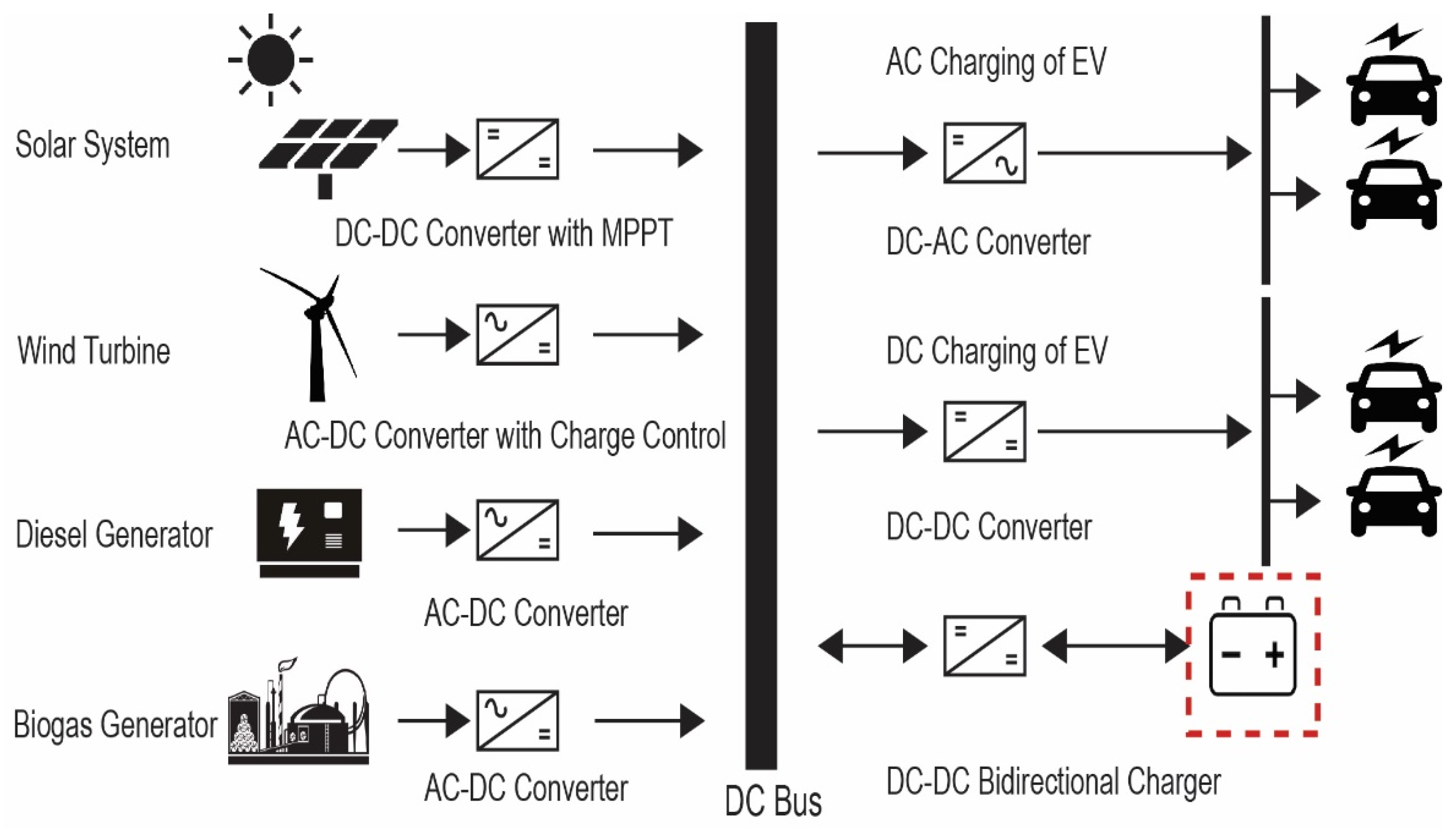

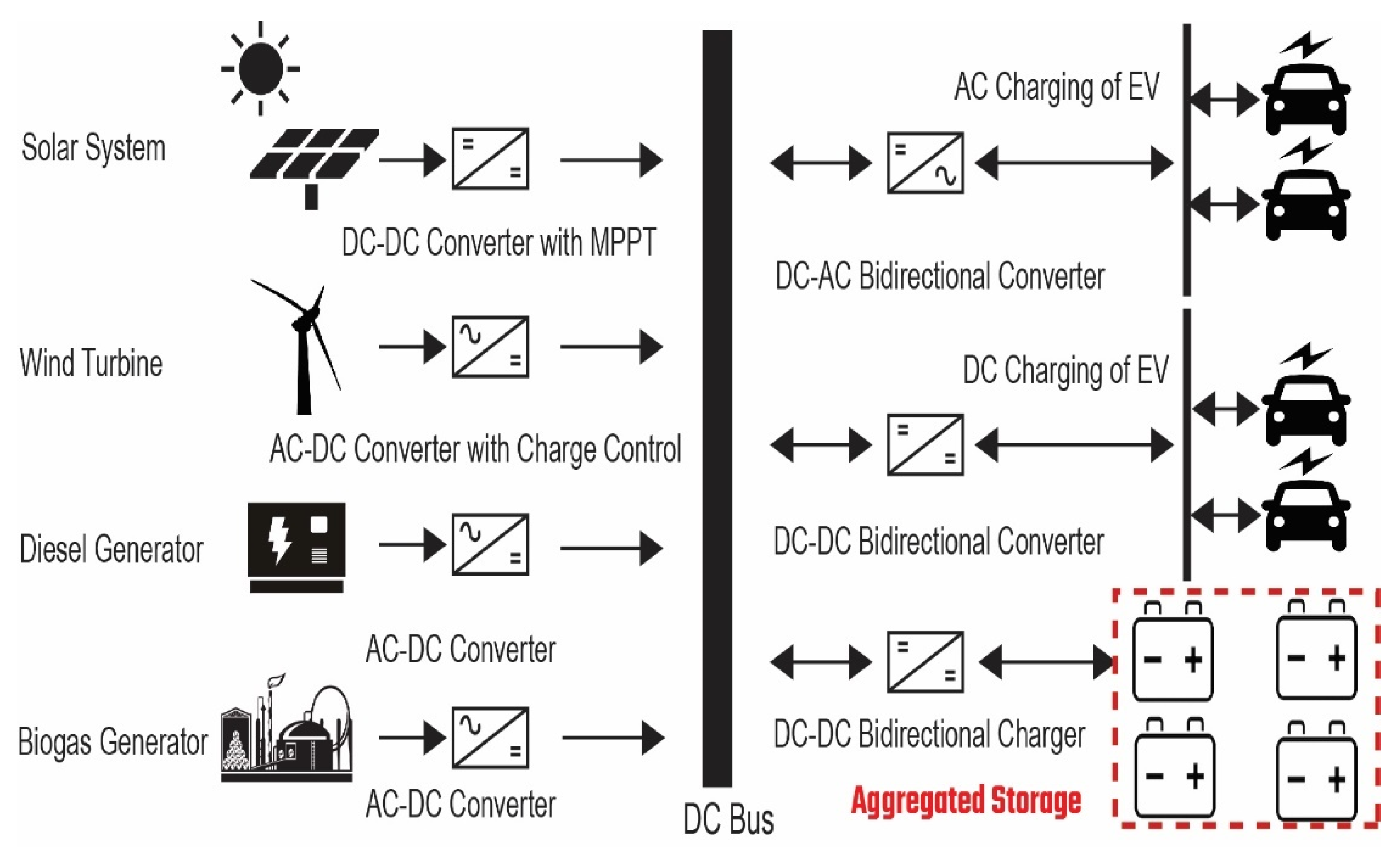
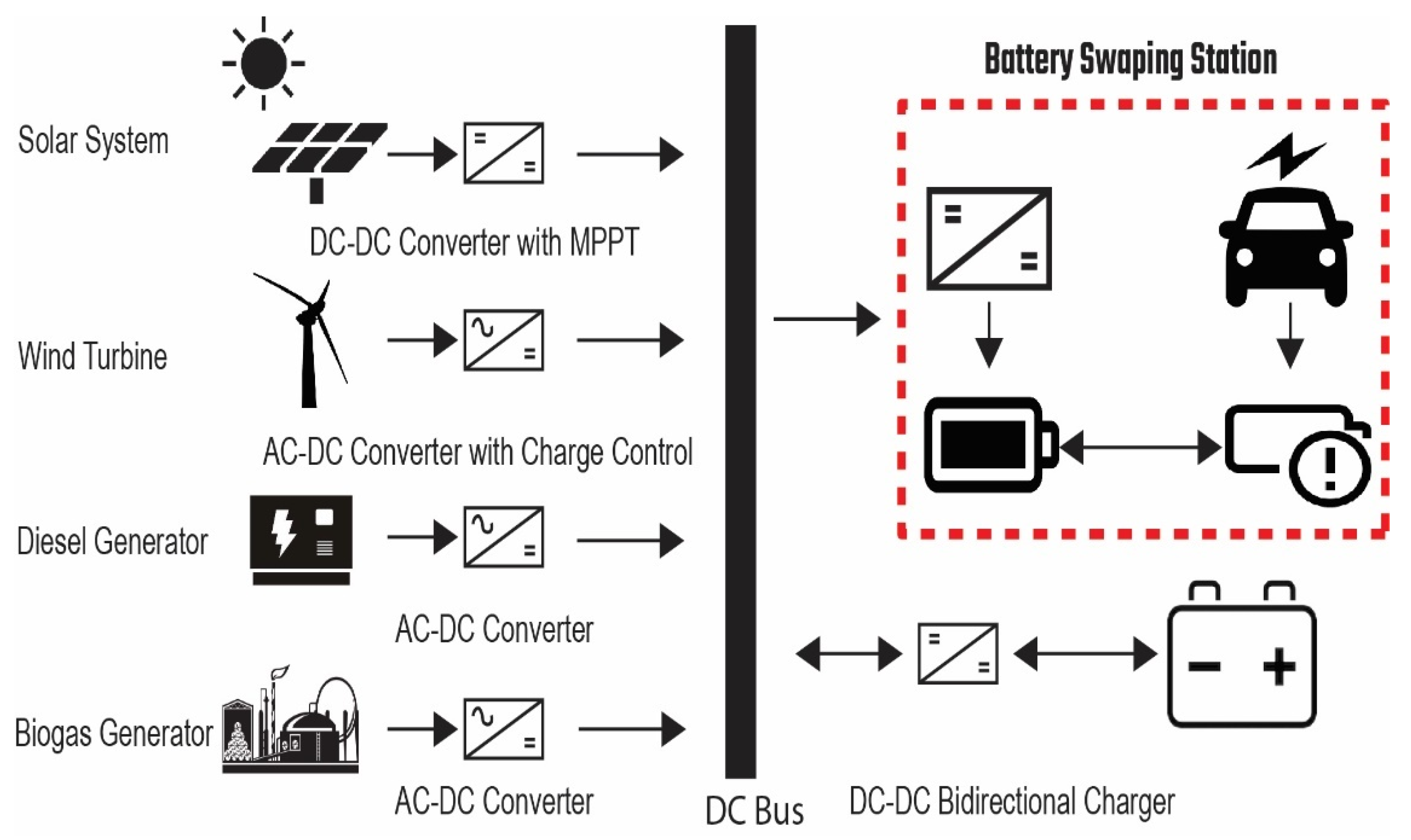
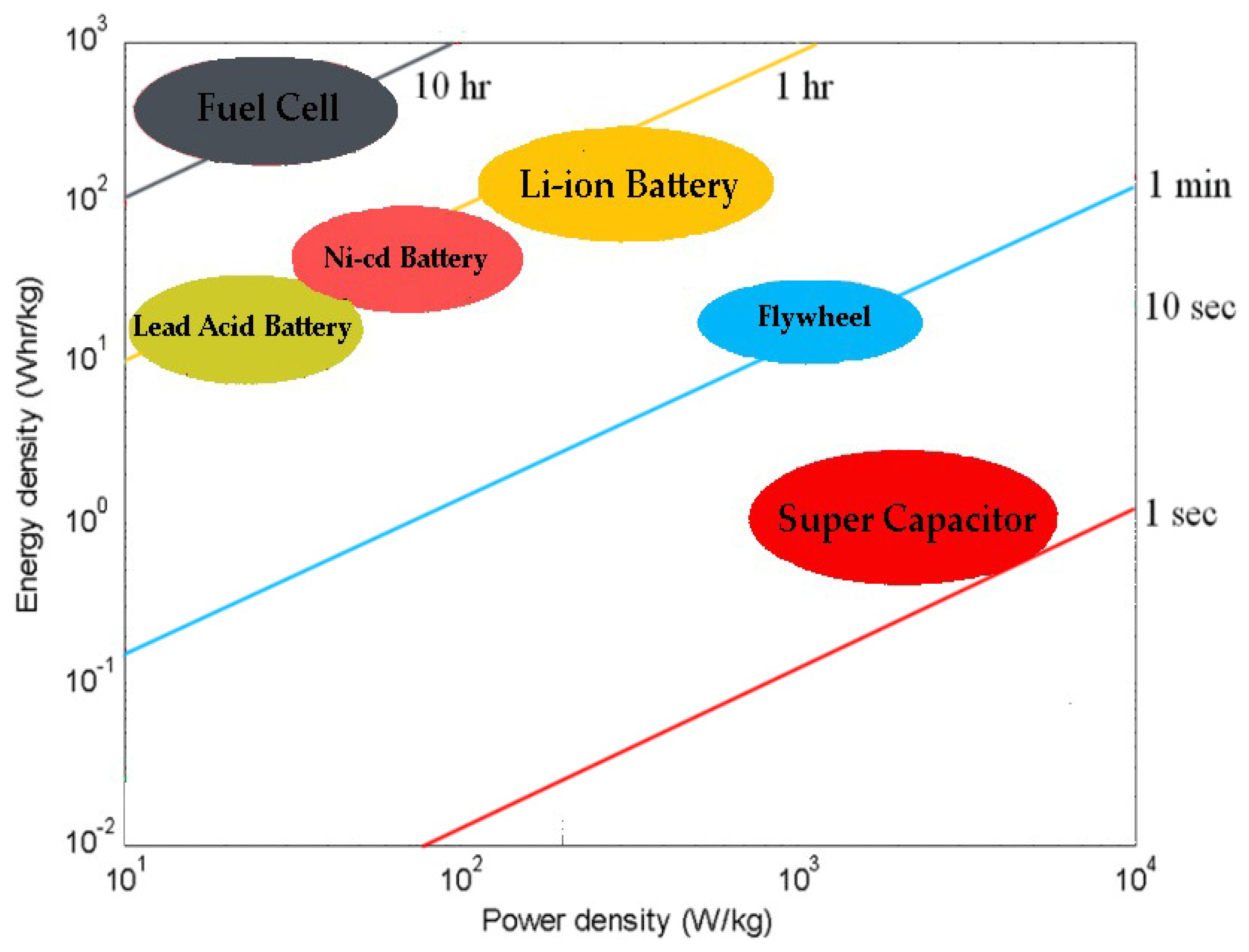
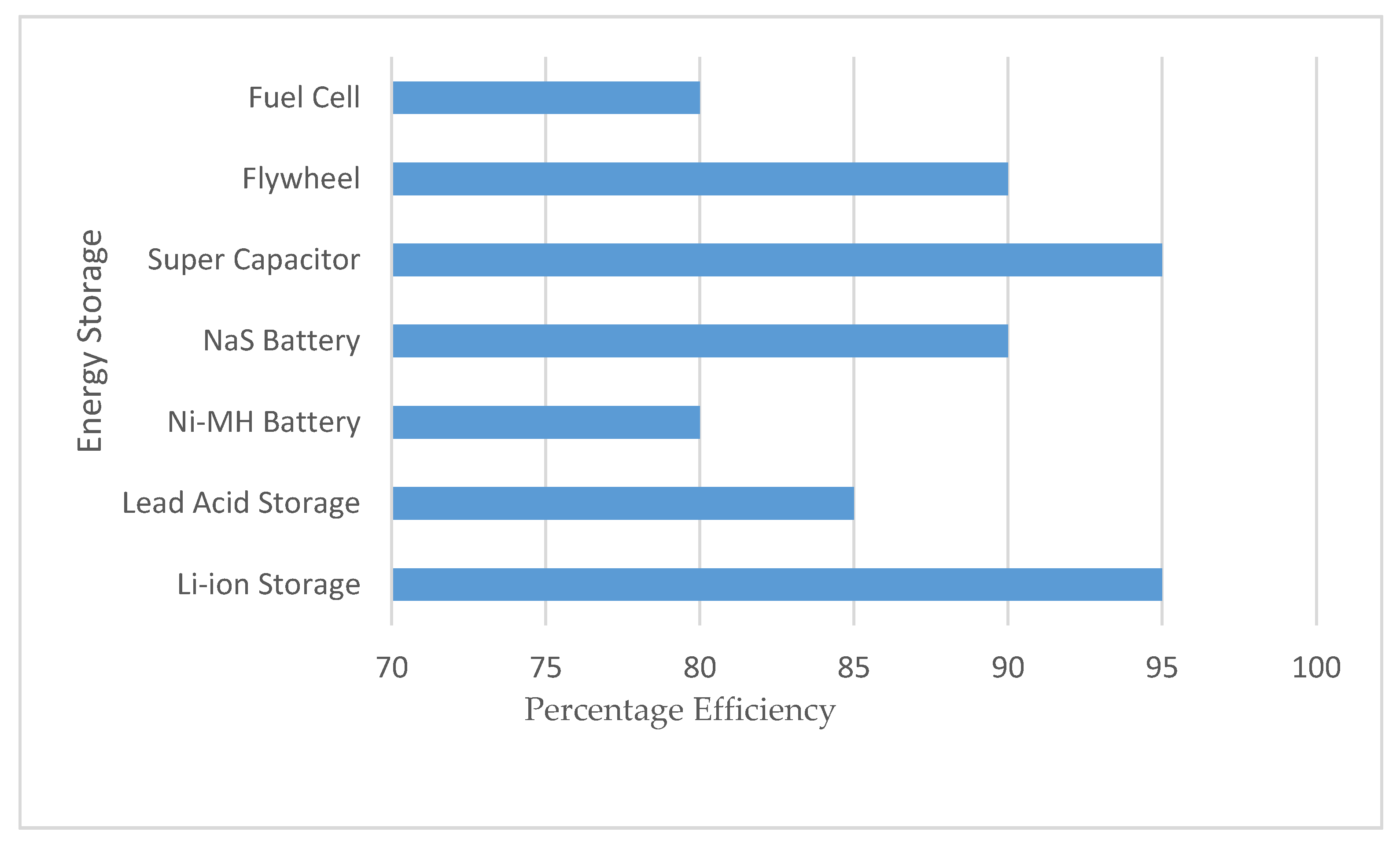
| Storage Technology | Storage Type |
|---|---|
| Mechanical | Flywheel Storage, Pumped Hydro Energy Storage (PHES), Compressed Air Energy Storage (CAES). |
| Electrical | Super Capacitor, Super Magnetic Storage |
| Electrochemical | Battery Storage (Li-ion, NiCad, Lead Acid, NaS) |
| Chemical | Fuel Cells, Hydrogen Storage, Biofuels |
| Thermal | Hot and Cold-Water Storage, Molten Salt Storage, Latent Heat Storage |
| Storage Type | Advantage | Disadvantage |
|---|---|---|
| Lead Acid Battery | Cheap and high-power capacity | Less Efficient, Cause environmental pollution |
| Li-ion Battery | High efficiency and more energy density | High cost for commercial applications |
| Super Capacitor (SC) | Long life and more efficiently | Less energy density, Fewer applications |
| Compressed Air Energy Storage (CAES) | High power capacity and long life | Less efficient, siting problem |
| Flywheels | Power capacity, lifetime and efficiency are higher | Less energy density |
| Pumped Hydro Energy Storage (PHES) | Very high-power capacity and long life | Not fit for every site, environmental issues, moderate efficiency |
| Superconducting Magnetic Energy Storage (SMES) | High power capacity and high efficiency | Huge production cost, Low energy density |
| Hydrogen Energy Storage | Free from GHS emission, high energy density and most suitable for hydrogen fuel vehicles | Obscure storage and transportation requirements, expensive & low efficiency |
| High Power Storage | High Energy Storage |
|---|---|
| Supercapacitor | CAES |
| Flywheel | Li-ion Battery |
| Lead Acid Battery | Fuel Cell |
| Ref | Battery Configuration | Generation Resources | Type of Storage | Advantages | Disadvantages |
|---|---|---|---|---|---|
| [64] | Single Storage | Wind and Solar | Li-ion Battery |
|
|
| [65] | Single Storage | Wind and Solar | Lead Acid Battery |
|
|
| [66] | Single Storage | Solar and Biogas | Lead Acid Battery |
|
|
| [70] | Single Storage | Wind and Solar | Fuel Cell |
|
|
| [74] | Single Storage | Wind and Solar | Flywheel |
|
|
| [82] | Hybrid Storage | Solar | Li-ion Battery and Super Capacitor |
|
|
| [83] | Hybrid Storage | Wind and Solar | Li-ion Battery, Ammonia, Hydrogen Storage |
|
|
| [84] | Hybrid Storage | Solar | FC and Hydrogen |
|
|
| [85] | Hybrid Storage | Wind and Solar | Battery and FC |
|
|
| [86] | Hybrid Storage | Wind and Solar | FC and SC |
|
|
| [87] | Hybrid Storage | Solar | Flywheel and LiFePO4 |
|
|
| [93] | Swappable Storage | Solar | Li-ion Batteries |
|
|
| [94] | Swappable Storage | Wind | Lead-acid batteries |
|
|
| [99] | Swappable Storage | Solar, Wind and Geothermal | Li-ion Batteries, PHES |
|
|
| [100] | Swappable Storage | Wind and Solar | Li-ion Batteries |
|
|
| [101] | Swappable Storage | Wind and Solar | Li-ion Batteries |
|
|
| ESS Type | Storage Capacity (MWh) |
|---|---|
| Flywheel | 0–25 |
| Fuel Cell | 0–50 |
| Lead Acid Storage | 0.3–50 |
| Super Capacitor | <0.28 |
| Li-ion Battery | 0.3–25 |
Publisher’s Note: MDPI stays neutral with regard to jurisdictional claims in published maps and institutional affiliations. |
© 2022 by the authors. Licensee MDPI, Basel, Switzerland. This article is an open access article distributed under the terms and conditions of the Creative Commons Attribution (CC BY) license (https://creativecommons.org/licenses/by/4.0/).
Share and Cite
Ali, A.; Shakoor, R.; Raheem, A.; Muqeet, H.A.u.; Awais, Q.; Khan, A.A.; Jamil, M. Latest Energy Storage Trends in Multi-Energy Standalone Electric Vehicle Charging Stations: A Comprehensive Study. Energies 2022, 15, 4727. https://doi.org/10.3390/en15134727
Ali A, Shakoor R, Raheem A, Muqeet HAu, Awais Q, Khan AA, Jamil M. Latest Energy Storage Trends in Multi-Energy Standalone Electric Vehicle Charging Stations: A Comprehensive Study. Energies. 2022; 15(13):4727. https://doi.org/10.3390/en15134727
Chicago/Turabian StyleAli, Amad, Rabia Shakoor, Abdur Raheem, Hafiz Abd ul Muqeet, Qasim Awais, Ashraf Ali Khan, and Mohsin Jamil. 2022. "Latest Energy Storage Trends in Multi-Energy Standalone Electric Vehicle Charging Stations: A Comprehensive Study" Energies 15, no. 13: 4727. https://doi.org/10.3390/en15134727







